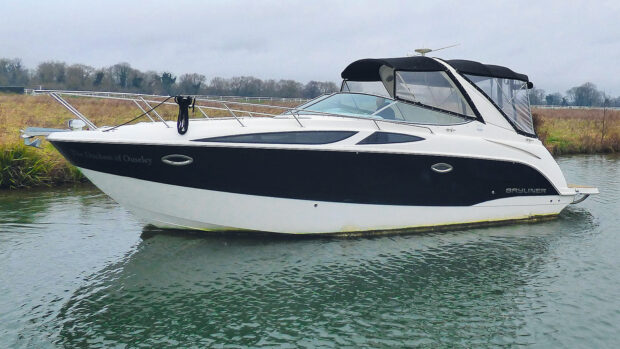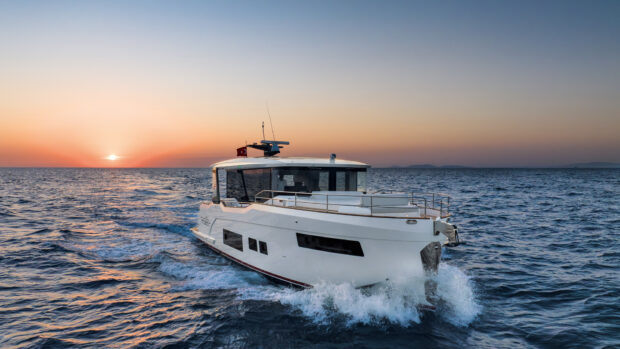Is it a RIB, is it a sportscruiser or is something completely different? We find out for ourselves with the first UK test of the Agapi 950
Have you noticed how every new concept claims to have been originally drawn up on a table napkin? Well, on one of Agapi’s promotional videos there’s a photograph of the very napkin upon which the concept of Agapi was born.
It was drawn in 2006 by Peder Asplund, CEO of Agapi. Based in Sweden, at the time, boating for Peder was just for fun. “In 2005, we had four boats in our family. We had a really nice 36ft flybridge boat, an Aquador 23, a waterskiing boat and a 9m RIB. I was working for Ericsson, and all the maintenance of the boats drove me crazy.
“What was interesting was that of all the boats, the RIB became the clear favourite – it was the boat we naturally gravitated toward for days out. We could take three families, it was extremely fast, fun to drive and everyone loved it. In addition, we kept the boat on a trailer, so there were no berthing fees and very little maintenance.

The Agapi 950 is available with either a big single or twin outboard engines
“But there was one big disadvantage. The Swedish weather could be gorgeous in the morning and then change. My wife, who is from Argentina, perhaps felt this most of all. We realised that what we needed were the benefits of the RIB combined with the weather protection of the Aquador and the facilities of the flybridge boat. We needed to be able to sleep four on occasion and we needed the separate toilet and the ability to cook on board. But also we needed the ability to weatherproof the cockpit.”
It was those requirements that sent Peder on a hunt for the perfect RIB. But despite a very thorough search, he eventually concluded that no such boat existed. “There are plenty of cabin RIBs out there but most of them are what I would describe as quite macho – they are low, fast, high-performance boats. What I wanted was something fast but more family orientated.” Which is when that napkin came out…
From conception to production
It took four years for the boat to be designed and production to be set up in Poland. In 2010, the Agapi 950 was born and the boat you see on these pages is the very first to be imported into the UK by Williams Marine and Watersports Ltd.
One of Peder’s key design tenets was proven by Williams Marine MD Mark Williams from the get go. He drove to Poland, hitched the boat up to his Toyota Hilux and simply drove 1,200 miles home with it. “The tubes have to be deflated in order for it to be strictly legal but once you’ve done that, it’s good to go,” Mark tells me.
Article continues below…

VIDEO: Brig Eagle 10 review

VIDEO: Jeanneau Cap Camarat 9.0 twin test
The French yard’s latest offerings are both remarkably fast, capable craft. But which Jeanneau Cap Camarat 9.0 is the better
When I catch up with Mark and the boat, it’s already afloat at Premier Marina’s dry stack facility in Swanwick. It’s a quirky-looking machine but cool with it. The bow looks high, with more vertical white GRP topsides forward than you’d normally see on a typical RIB and slim tubes that taper down to the waterline aft.
Step on board and the vibe is far more family sportscruiser than fast RIB. There’s not a jockey seat in sight. Instead, the aft section of the cockpit is dominated by a three-sided square of seating, the aft backrest of which cunningly slides to create either a sunbathing area or rear-facing bench when you’re at anchor.
The whole aft seat also lifts on powered rams to gain access to a massive locker with a folding cockpit table secured beneath its lid. Further forward, the double helm seat flips over to join the party, creating the fourth side of the sociable square of seating and revealing a stove, sink and fridge.

The sociable aft seating arrangement includes a table stowed under the rear bench
Head down below and you discover the reason for those tall forward GRP sections – far more headroom than you’d expect (albeit not quite standing) in the minimalist cabin. There’s no actual seating down here. Instead, it’s laid out as a generous single (or cosy tapering double) berth aft and another larger double further forward.
But crucially, there’s a proper separate heads compartment with a Dometic electric flush loo. Putting the toilet in its own compartment rather than under a berth might seem a small detail but it makes a huge difference to people’s willingness to use it, and of course at night, when all the berths are occupied, it’s transformational.
Test drive
But I’m not here to sleep (or use the loo!), so I head back up to the cockpit, flip the helm seat back to its driving position and fire up the two Yamaha outboard engines. At 300hp each, they represent the most powerful option available; a single 350hp is more typical.
Pottering down the Hamble at the regulation 6 knots is a good time to take in my surroundings. Like the cockpit layout, the helm is most unRIB-like: very high sided with a tall square windscreen set well forward.

This isn’t its most flattering angle but with the covers packed away, the Agapi 950 is a good-looking craft
This boat is fitted with the optional carbon-fibre hardtop (most are) which, as well as providing the perfect location for a solar panel and lights, adds to the enclosed cosseted feeling, especially with the clear side and front roll-away perspex screens linking it to the fixed windscreen.
It creates an incredibly sheltered driving environment, something very welcome when we reach the blustery Southampton Water and finally get to exercise those monster outboards. Performance is scintillating.
Much effort was put into keeping the weight down, in part to make it easier to trailer, but the resultant power-to-weight ratio means there is instant shove on tap whether at 3 knots or 30. In fact, 30 knots at 3,500rpm feels very natural.
Relatively parsimonious too at 2mpg – a Jeanneau Cap Camarat 9.0 with twin 250hp engines is returning 1.5mpg at the same speed. Keeping the throttles pinned winds us out to an exhilarating 49 knots, the hull feeling entirely comfortable at that gait.

The rear berth is a good- sized single bed or a (very) small double
The only anomaly is a tendency to wander slightly at planing speeds, which requires constant helm correction. It’s a very blustery day however, and I wonder how much effect the wind is having on those tall topsides forward.
The other interesting anomaly is a propensity for one engine to cavitate in hard turns. In itself, that’s not unusual in powerful twin-engine boats as the outer engine lifts toward the surface, but strangely, it’s the inner engine that lets go.
Heading out into the Solent in search of more challenging conditions reveals a hull well able to cope with the short sharp Solent chop. What’s less expected is the ability to drop the speed back and back with zero bow lift, particularly given the weight of those engines aft. Still, planing with the bow down at 12 knots is almost surreal.

A separate heads is a rare luxury on a 9m RIB and transforms its useability
Our verdict
So does it live up to Peder Asplund’s ambition? I think that’s an unqualified yes. It ticks the RIB boxes of a safe boat that’s fun to drive and can be trailered (just!), yet it provides sleeping for four and something akin to wheelhouse levels of shelter when you want it. It’s a difficult boat to pigeonhole – technically it’s a RIB but actually, it looks and feels quite different. What I think we have here is the first aquatic SUV, and if the concept takes off as it has for cars then Peder is really on to something!
Specifications
Build: GRP
RCD category: C for 12
LOA: 32ft 10in (10m)
Beam (tubes inflated): 10ft 10in (3.06m)
Engines: Twin Yamaha F3000 300hp outboards
Top speed: 49 knots
Cruising speed: 25 knots
Consumption: 53lph
Range: 177 miles
Noise: 60 dB
Fuel: 480 litres (105 gallons)
Water: 90 litres (20 gallons)
Price from: £150,000 (inc VAT)
Price as tested: £172,950 (inc VAT)










